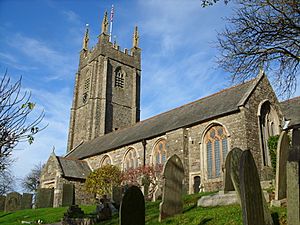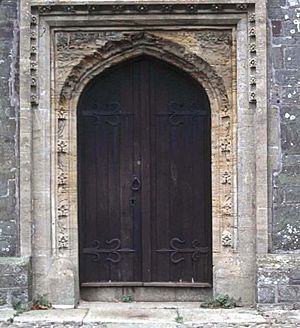St Andrew's Church, Stratton facts for kids
Quick facts for kids St Andrew's Church, Stratton |
|
|---|---|

Stratton church
|
|
| Denomination | Church of England |
| History | |
| Dedication | St Andrew |
| Administration | |
| Parish | Bude-Stratton |
| Deanery | Stratton |
| Archdeaconry | Bodmin |
| Diocese | Truro |
| Province | Canterbury |
St Andrew's Church is a very old and important church. It is located in Stratton, a town near Bude in Cornwall. You can find it right on the main road in Stratton.
This church is so special that it is called a Grade I listed building. This means it is one of the most important historic buildings in England! It got this special status on March 5, 1952. Some parts of the church, like the font, are from the 1100s. Other parts, like the north aisle, were built in the mid-1300s. The tower and other sections were added in the 1400s. The church was carefully fixed up in 1888 by two people named James Piers St Aubyn and Henry J. Wadling.
Contents
Exploring St Andrew's Church
The oldest part of the church building is the north aisle. This section was built in the mid-1300s. The south aisle, the chancel (the area around the altar), and the tower were added later, in the 1400s.
Ancient Features
The font is even older than these parts. It dates all the way back to the 1100s! A vestry, which is a room used by the clergy, was added in the late 1800s. In 1888, the church was restored and partly rebuilt. This work was done by James Piers St Aubyn and Henry J. Wadling.
Building Materials and Style
The north aisle of the church is made from rough stone. The chancel, south aisle, and tower are built from smooth, cut stone called ashlar masonry. The south arcade, which is a row of arches, is made of granite.
The church is mostly built in the Perpendicular style. This style was popular in England from the late 1300s to the early 1500s. However, the north arcade is built in an earlier style called Decorated style. The porch has granite on its edges and corners. Its arched granite doorway is below a sundial on the roof.
Inside the Church
Inside, most of the walls are covered with plaster. The roof is likely the original one. It is an open waggon roof with carved ribs and decorative bosses (carved knobs).
The bowl of the font is from the 1100s. It sits on a base that was added in the 1800s. The pulpit, where sermons are given, is from the 1600s. It has five sides and stands on a wineglass-shaped base. The pulpit has panels with round-headed arches carved into them.
On the south side, there is a staircase that once led to a rood loft. A rood screen, which is a decorative screen, was added in 1901. You can also see some beautiful windows in the north aisle and the tower.


